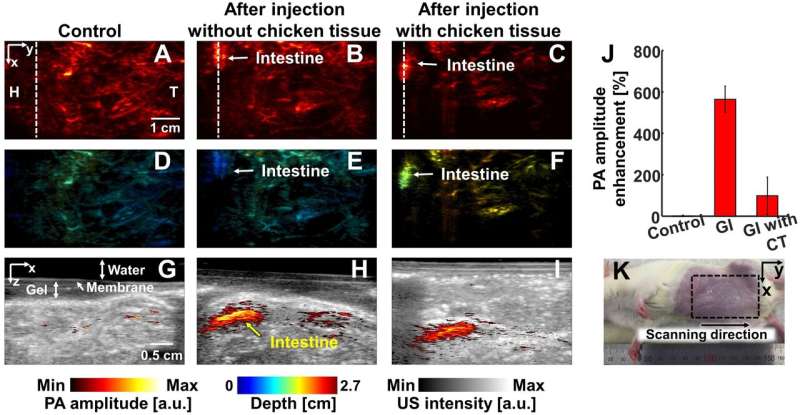Exploring the deep tissues using photoacoustic imaging

Photoacoustic imaging has gained global attention for capturing images without causing pain or using ionizing radiation. Recently, many researchers have heavily studied observing deep tissues to apply photoacoustic imaging to clinical diagnosis and practices.
Prof. Chulhong Kim of Creative IT Engineering from POSTECH and his student, Byullee Park conducted joint research with Prof. Hyungwoo Kim and Kyung Min Lee of Cheonnam National University and proposed a new contrast agent for the photoacoustic imaging of deep tissues. They used a nickel-based nanoparticle as a contrast agent that absorbs light at 1,064 nm wavelength. They obtained images of the tissues penetrating to a maximum 3.4 cm depth in live animals which is the deepest image observed using this wavelength compared to the previous studies.
The principle of photoacoustic imaging is that it allows lights to be absorbed by tissues which then causes a thermoelastic expansion of the tissues of the organs instantly. This generates sound waves (photoacoustic) signals that are detected as ultrasound wave sensors, producing images. The conventional optical microscopic imaging technologies only allow observing tissues 1 mm in depth. On the other hand, the photoacoustic imaging system produces images of deep tissues in animals and humans based on optical contrast.
However, photoacoustic imaging is challenging despite intense research activities to observe deep tissues in various organs more closely. It is difficult to deliver enough light at 650-900nm wavelength with an affordable cost to deep tissues in the body. For this reason, the commercial and clinical translation of photoacoustic imaging are challenging.
To improve this limitation of photoacoustic imaging, the research team introduced a nanoparticle nickel-based contrast agent, that absorbs light specifically and strongly at 1,064 nm wavelength, to observe deep tissues. They verified biocompatibility of nickel-based nanoparticles and obtained photoacoustic images in deep tissues (3.4 cm depth) of lymph nodes, gastrointestinal tracts, and bladders of live rats by inserting the nanoparticles.
The first author of the paper, Byullee Park said, "This research is different from the previous studies that used short wavelength. We used long wavelength lasers and were able to minimize damage in the tissues. We were also able to obtain images of deep tissues by delivering lights to organs located deep inside of the animal."
When this newly developed photoacoustic imaging technique is applied to clinical practices, it can help diagnosis of diseases related to deep organs by producing images noninvasively and without a risk of exposure to radiation, unlike other imaging methods that use radiation, such as computed tomography (CT). Furthermore, lasers of 1,064 nm wavelength are comparatively economical, and can be used with other commercial ultrasound machines, which makes likely its early clinical applications.
"Our research is the first example of imaging the deepest tissues in the body among all the research papers on photoacoustic imaging so far. It is very meaningful that it has taken a step further to bring clinical feasibility of photoacoustic imaging," said Prof. Chulhong Kim, the corresponding author of the paper.
More information: Byullee Park et al, Deep tissue photoacoustic imaging of nickel(II) dithiolene-containing polymeric nanoparticles in the second near-infrared window, Theranostics (2020). DOI: 10.7150/thno.39403




















